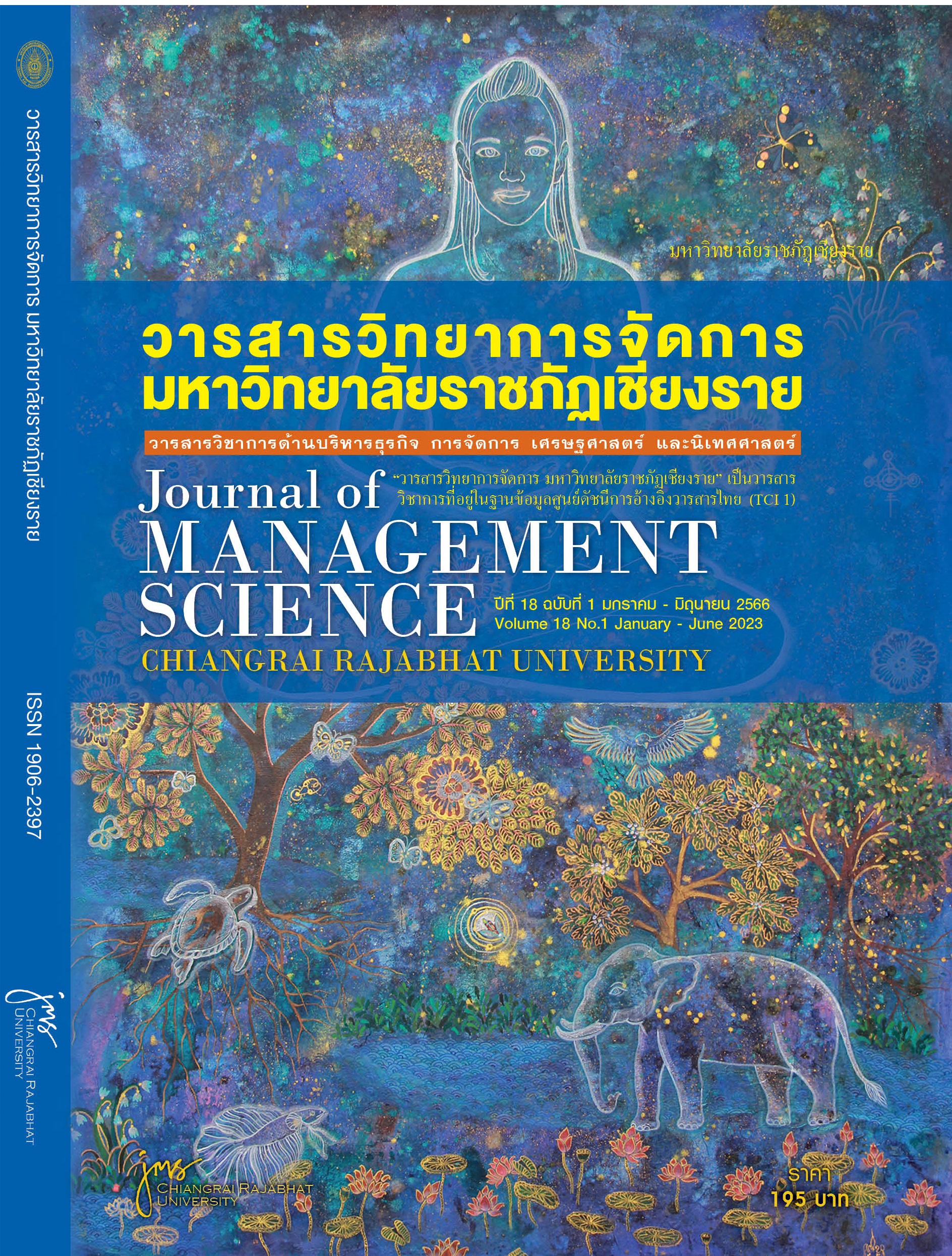Effects of Risk Attitudes and Time Preferences on Teenage Smoking in Chiang Mai Province
Main Article Content
Abstract
This study examined risk attitudes and time preferences to determine the influence on male adolescents' decision to smoke in Chiang Mai province. The study was conducted with 313 individuals aged 15 to 24 years who had lived in Chiang Mai for at least one year and completed online questionnaires between August and December 2022. Risk attitudes and time preferences were assessed differently from the experiment, which asked the sample to decide based on hypothetical situations. The study found that male adolescents who had close contacts with smokers caused the subjects to smoke more. Risk attitude did not influence smoking choice or amount smoked. However, time preference did influence smoking behavior. Discount rate was positively correlated with smoking choice and amount smoked. That is, people who prefer higher current consumption tend to smoke more.
Article Details

This work is licensed under a Creative Commons Attribution-NonCommercial-NoDerivatives 4.0 International License.
Views and opinions expressed in the journal do not necessarily reflect those of the editors.
References
Anderson, R. L, & Mellor, M. J. (2008). Predicting health behaviors with an experimental measure of risk preference. Journal of Health Economics. 27(5), 1260 – 1274.
Attanan, W., & Sae Lim, U. (2012). Study on Thai youth smoking behaviors and factors affecting their smoking behaviors in Bangkok. Proceedings of 50th Kasetsart University Annual Conference: Education, Economics and Business Administration, Humanities and Social Sciences. Kasetsart University Academic Conference No. 50. (183-190). The Thailand Research Fund, Bangkok (Thailand).
Becker, G.S, & Murphy, K. M. (1988). A theory of rational addiction. Journal of Political Economy. 96(4), 675-700.
Bunserm, C., Suthitivanich, P. & Rawisanon, W. (2009). A Survey of Smoking Behavior among Youth in Chaiyaphum Province. Journal of Health Science Research. 3(2), 6-14.
Center for Research and Knowledge Management for Tobacco Control (2018). Thailand Tobacco Consumption Statistics Report 2018. https://shorturl.asia/fv0Au
Gruber, J. & Köszegi, B. (2001). Is Addiction Rational? Theory and Evidence. The Quarterly Journal of Economics. 116(4), 1261-1303.
Harrison,G., Lau, I. M., & Williams, B. M. (2002). Estimating Individual Discount Rates in Denmark: A Field Experiment. The American Economic Review. 92(5), 1606 – 1617.
Harrison,G., Morten, I., & E.,E.R. (2010). Individual discount rate and smoking: Evidence from a field experiment in Denmark. Journal of health economics. 29(5), 708-717.
Harrison, G., Hofmeyr, A., Ross, D.& Swarthout, T. J. (2018). Risk Preferences, Time Preferences, and Smoking Behavior, Southern Economic Journal. 85(2), 313-348.
Heatherton, T.F., Kozlowski, L.T., & Fagerstrom, K. O. (1991) The Fagerström Test for Nicotine Dependence: a revision of the Fagerström Tolerance Questionnaire. Journal of National Library of Medicine. 86(9),1119 – 1127.
Hershfield, H. E., Goldstein, D. G., Sharpe, W. F., Fox, J., Yeykelis, L., Carstensen, L. L., & Bailenson, J. N. (2019). Increasing saving behavior through age-progressed renderings of the future self. Journal of marketing research. 48(SPL), 23-37.
Himakalasa, W. (2018). The research report provided Atlanta's data on policies that avoid these things. (Research Report). Institute of Public Policy Studies Foundation.
Holt, A.C., & Laury, K. S. (2002). Risk Aversion and Incentive Effects. Journal of American Economic Review. 92(5), 1644-1655.
Ida, T., & Goto, R. (2009). Simultaneous Measurement of Time and Risk Preferences: Stated Preference Discrete Choice Modeling Analysis Depending on Smoking Behavior. Interational Economic Review. 50(4), 1169-1182.
Inmunkong, S. (2008). A Study of the smoking behavior and developing of the program for decreasing smoking behaviors of female students. (Master of Education Thesis). Srinakharinwirot University
Jaruchit, S., Srisuriyawet, R., & Homsin, P. (2015). Factors related to regular smoking among male students. vocational college Chanthaburi Province Journal of Nursing and Education. 8(1), 59-71.
Jinkyung, N., Chih-Mao, H., & Denise, C. P. (2017) When Age and Culture Interact in an Easy and Yet Cognitively Demanding Task: Older Adults, But Not Younger Adults, Showed the Expected Cultural Differences. Journal frontiers in Psychology. 1-11.
Komonpaisarn, T. (2020). The Estimation of Economic Cost of Tobacco Smoking in Thailand 2017. (Research Report). Center for Research and Knowledge Management for Tobacco Control
Kuder, G. F., & Richardson, M. W. (1937). The theory of the estimation of test reliability. Journal of Psychometrika. 151–160.
Miura, T. (2019). Does time preference affect smoking behavior? a dynamic panel analysis. Journal of Behavioral and Experimental Economics. 170-180.
National Statistical Office. (2019). Demographic Statistics. Population and housing. Retrieved August 24, 2020, from http://statbbi.nso.go.th/staticreport/ page/sector/th/01.aspx
Pfeifer, C. (2012). A Note on Smoking Behavior and Health Risk Taking. Nordic Journal of Health Economics. 135-151.
Taphaopong, J. (2007). Smoking behavior of students during the third grade at Srinakharinwirot University Demonstration School, Pathumwan. (Master of Education). Srinakharinwirot University.
Thongluea, K. (2007). Factors related to smoking among male vocational students. Samut Songkhram Province (Degree Thesis). Kasetsart University
Tobin, J. (1958). Estimation of relationships for limited dependent variables. Journal of Econometrica. 26(1), 24 –36.
United Nations. (2020). Department of Economic and Social Affairs. Retrieved August 18, 2020, from https://www.un.org/%20development/desa/youth/what-we-do/faq.html
World Health Organization. (2011). Tobacco questions for surveys: a subset of key questions from the Global Adult Tobacco Survey (GATS): global tobacco surveillance system. Retrieved August 18, 2020, from https://apps.who.int/iris/handle/10665/87331
World Health Organization. (2020). Tabacco. Retrieved August 18, 2020, from https://www.who.int/news-room/fact- sheets/detail/tobacco


